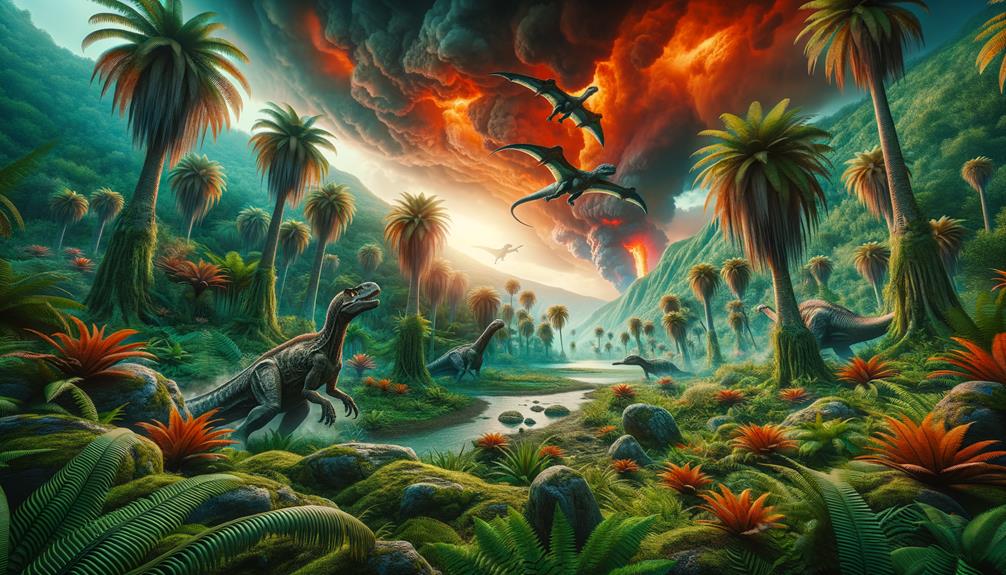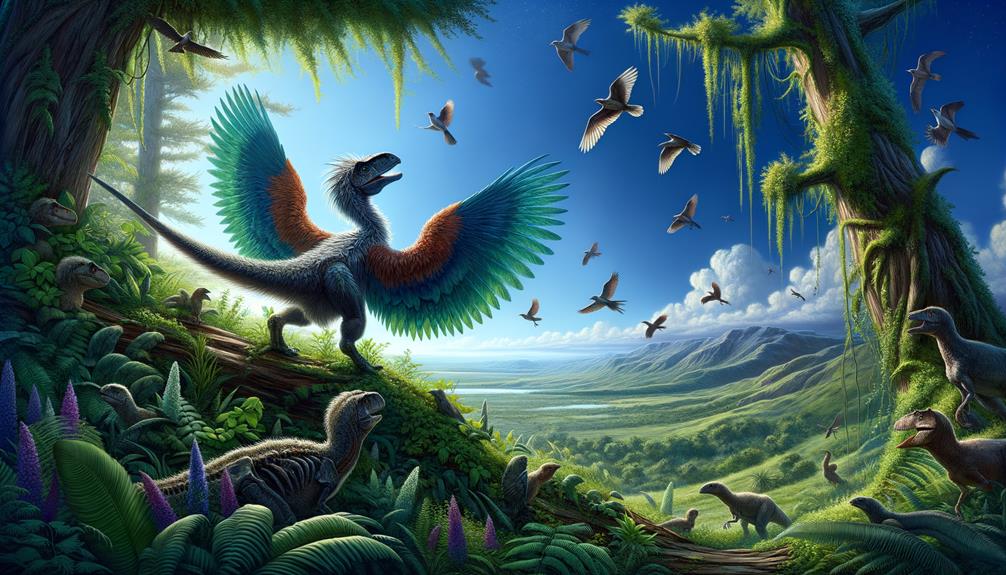I've always been fascinated by the remarkable resilience of crocodilians, which have thrived for an astonishing 247 million years. These ancient creatures evolved from a group of dinosaurs, developing powerful jaws and adaptability that allowed them to dominate their ecosystems as top predators. Their ability to regulate their body temperature and transition between freshwater habitats enabled them to survive through dramatic climate shifts. Despite the challenges posed by rising sea levels, which affect coastal habitats, freshwater species have shown impressive flexibility. This adaptability underscores their remarkable resilience. To ensure their continued survival, it's crucial to preserve critical habitats and develop strategies that help them cope with environmental pressures. The remarkable traits that have enabled crocodilians to defy environmental challenges for millions of years hold important lessons for their future.
Key Takeaways
Crocodilians have been around for an astonishing 247 million years, demonstrating remarkable staying power in the face of changing environments. Freshwater habitats provided a safe haven, allowing these creatures to ride out shifts in the climate. Their ability to adapt, such as developing powerful bite forces and thermoregulation, helped them cope with environmental pressures. Additionally, their ecological flexibility allowed them to thrive in both freshwater and brackish habitats. As the planet continues to change, conservation efforts are vital to protect crocodilian habitats and ensure their continued survival.
Evolutionary History
Crocodilians have been around for an impressive 247 million years, making them a testament to resilience and adaptability in the face of profound ecological changes. The fossil record shows that early crocodilians were incredibly diverse, with hundreds of species thriving in different ecological niches. However, over time, this diversity dwindled, leaving us with the limited number of extant crocodilian species we see today.
The crocodilian lineage branched off from the 'bird line' of dinosaurs, birds, and pterosaurs around 240 million years ago. Despite experiencing a decline in evolutionary rate, crocodilians have managed to survive and even thrive as apex predators. Their ability to do so can be attributed to several factors, including their extremely powerful bite forces, which are among the highest recorded in the animal kingdom.
Living crocodiles are a prime example of evolutionary success, having maintained their position at the top of the food chain for millions of years. The consistency of their anatomical and physiological traits, as seen in the fossil record, highlights their adaptability and resilience. This enduring legacy of crocodilian species is a testament to nature's capacity for persistence in the face of changing environments.
Role of Ecology
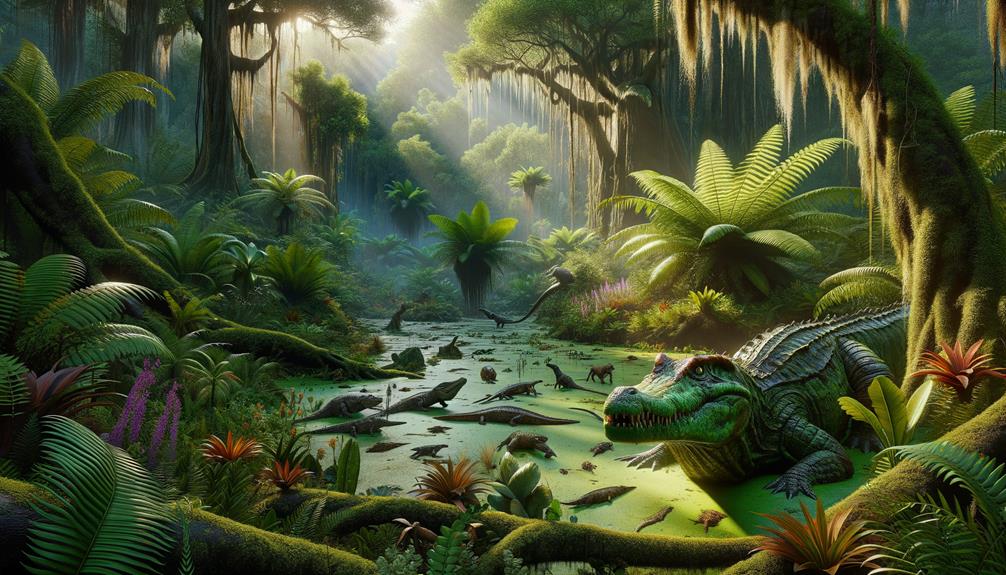
While exploring the role of ecology in crocodilian evolutionary resilience, it's essential to consider how diverse environmental pressures shaped the survival and extinction of various species over millions of years. The environments in which species thrived, such as aquatic or terrestrial habitats, greatly influenced their adaptability. Freshwater habitats, in particular, provided a safe haven for crocodilians, making them more resilient to climate change compared to their sea-dwelling counterparts.
Adaptations to freshwater environments allowed these species to better cope with temperature fluctuations and competition from other predatory species like sharks and dinosaurs. In contrast, crocodilians occupying coastal and estuarine habitats faced severe consequences, often leading to their extinction, due to rising sea levels. These ecological adaptations highlight the intricate relationship between a species and its environment, demonstrating how the ability to navigate different ecological niches determined survival.
Understanding these ecological dynamics provides valuable insights for predicting and managing the impacts of ongoing climate change on modern species. The resilience of freshwater-dwelling crocodilians serves as a testament to the importance of ecological flexibility in overcoming environmental challenges, a lesson that remains relevant today.
Resilience to Temperature Changes
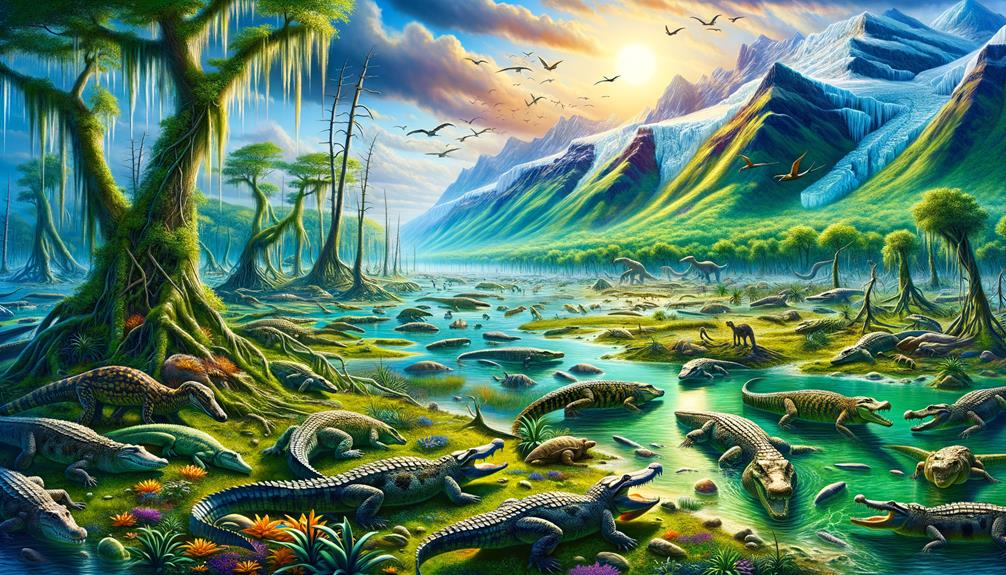
Examining the remarkable adaptations that enable crocodilians to endure temperature fluctuations reveals the critical role of their behavioral and physiological strategies in maintaining evolutionary resilience. Freshwater-dwelling crocodilian relatives were significantly more resilient to temperature changes compared to their sea-dwelling counterparts. This resilience is grounded in several key adaptations:
- Thermoregulation: Crocodilians regulate their body temperature by basking in the sun or seeking shade. This flexible thermoregulation is vital for their survival in diverse thermal environments.
- Physiological Strength: These reptiles generate the highest measured adult bite forces and tooth pressures, which are critical for their predatory efficiency and energy acquisition, especially in fluctuating temperatures.
- Ectothermic Nature: As ectotherms, crocodilians rely on external heat sources to maintain their body temperature, a trait that has allowed them to adapt to varying climate conditions over evolutionary timescales.
- Survival in Freshwater Environments: Fossil evidence shows that terrestrial and freshwater crocodilians could survive major climate shifts, underscoring their adaptability. Their closest living relatives also exhibit similar resilience.
These strategies demonstrate the intricate balance between behavioral and physiological mechanisms in ensuring the survival of crocodilian species amidst temperature changes.
Impact of Sea Level Rise
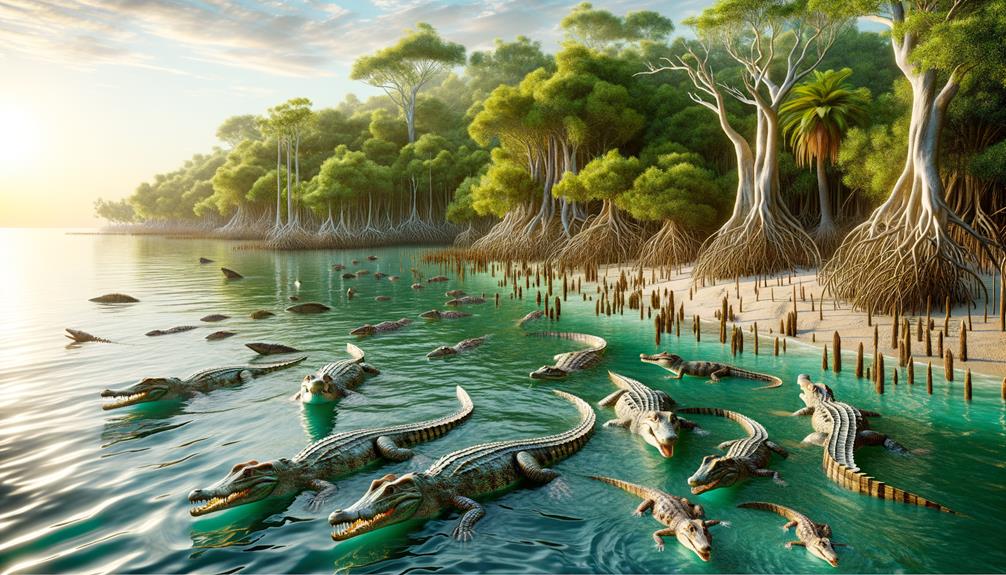
In the face of rising sea levels, freshwater-dwelling crocodilian species have shown remarkable resilience. They owe this ability to their ecological flexibility and capacity to adapt to changing environmental conditions. As sea levels surge, coastal and estuarine habitats are severely disrupted, putting species tied to these environments at risk. Freshwater crocodilians, on the other hand, have demonstrated impressive adaptability, leveraging their diverse habitat range and body size variations to mitigate the impacts of climate change.
Their ecological flexibility has played a crucial role in this resilience. By preferring freshwater environments, these species have avoided the brunt of sea level rise, which disproportionately affects coastal ecosystems. This adaptability has reduced their risk of extinction during periods of significant climatic upheaval, highlighting the importance of ecological flexibility in survival.
Analyzing the crocodilian family tree reveals that species able to navigate between freshwater and occasionally brackish habitats have had a significant evolutionary advantage. Their capacity to thrive in varied ecological niches underscores the need for targeted conservation strategies, ensuring these adaptable species continue to endure. Understanding their historical responses to sea level changes provides critical insights for contemporary conservation efforts amid ongoing climate change challenges.
Conservation Implications
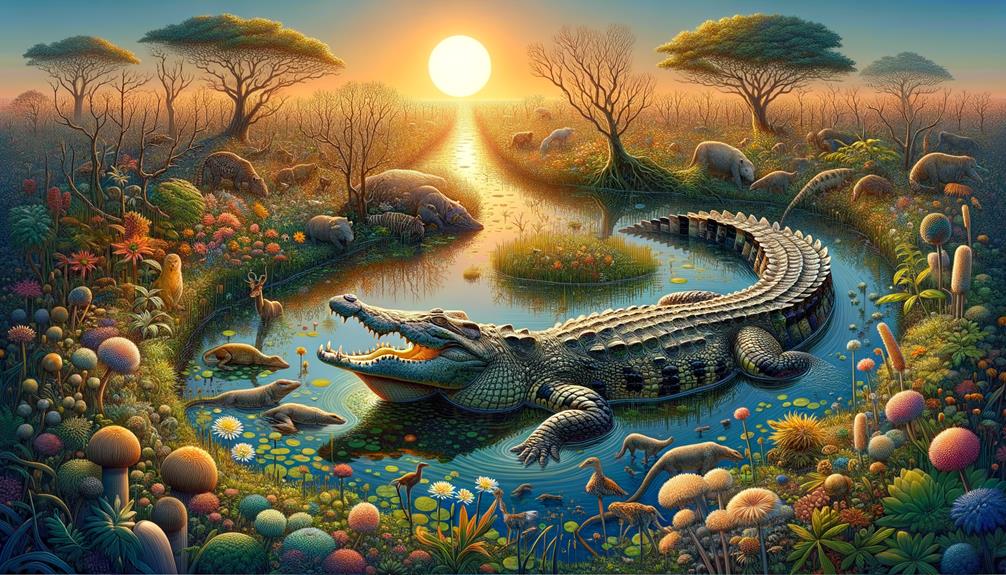
Given the alarming rate at which crocodile species are being categorized as Critically Endangered or Vulnerable, it's crucial we adopt a flexible approach to conservation that takes into account the impact of climate change. Rising sea levels threaten the very existence of freshwater-dwelling crocodile species, and their habitats require a multifaceted conservation strategy.
To ensure the survival of crocodile populations, we need to focus on:
- Preserving Habitats: Protecting and restoring critical habitats to mitigate the effects of rising sea levels and habitat loss.
- Adapting to Climate Change: Developing strategies that allow crocodile species to cope with changing environmental conditions, such as shifts in water salinity and temperature.
- Maintaining Ecosystem Balance: Promoting biodiversity to maintain ecosystem stability and support the complex interactions between species that are vital for crocodile survival.
- Ongoing Research and Monitoring: Conducting continuous research to better understand the factors driving species extinctions and the impact of climate change on crocodilian life histories and behaviors.
As one million species face extinction globally, understanding the intricate relationships between climate, species interactions, and ecosystem dynamics is vital. By integrating these conservation efforts, we can better protect the future of crocodiles and the biodiversity they represent.
Frequently Asked Questions
How Resilient Are Crocodiles?
Crocodiles have proven to be incredibly resilient creatures. They've managed to survive multiple mass extinctions and adapt to diverse environments, showcasing their remarkable ability to thrive in the face of adversity. With their powerful bite force and ancient lineage, it's clear that they're well-equipped to overcome numerous challenges.
What Is the Evolutionary History of Crocodilians?
Isn't it surprising that crocodilians, often seen as ancient and unchanged, have an evolutionary history spanning over 245 million years? They branched off from the ancestors of birds and survived dramatic environmental shifts, showcasing remarkable adaptability and resilience.
How Do Crocodiles Adaptations Help Them Survive?
Crocodiles' remarkable adaptations enable them to thrive in diverse environments. Their powerful jaws, armored skin, and ability to regulate their metabolism according to their surroundings allow them to survive in various conditions. Additionally, their cold-blooded physiology and complex social behaviors, such as parental care, help them adapt to environmental changes and ensure their survival and propagation.
How Have Crocodiles Survived so Long?
Crocodiles have managed to survive for millions of years due to their remarkable ability to adapt to different environments. Their powerful bite forces and diverse diets have allowed them to thrive in various ecosystems. Additionally, their evolving nesting behaviors have ensured their persistence over time.


